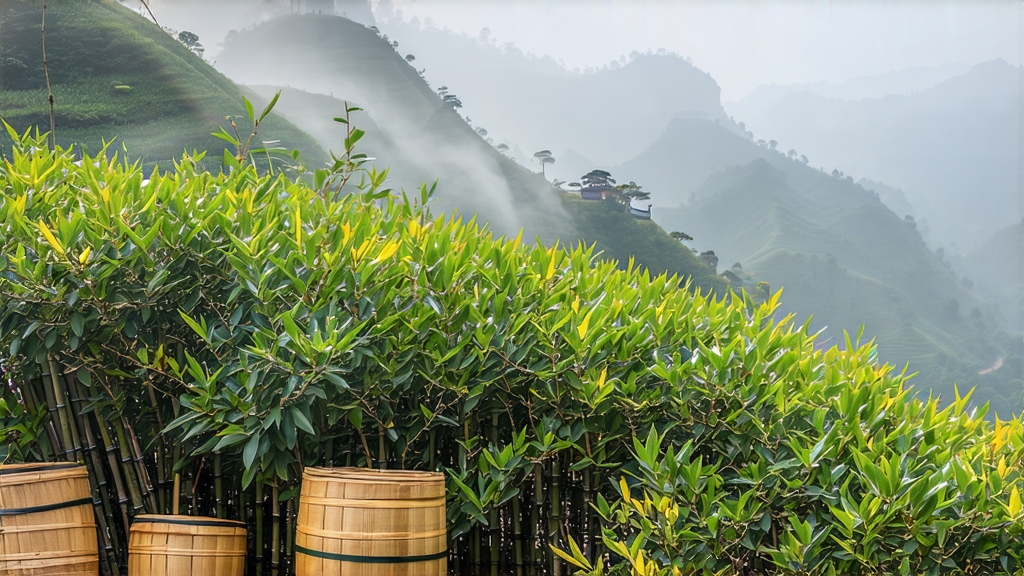
Tucked high in the mist-veiled Dabie Mountains of western Anhui Province, Huoshan Huangya has quietly embodied the elegance of China’s rarest tea category for more than fourteen centuries. While green tea commands global fame and pu-erh dominates investment portfolios, yellow tea—huang cha—remains a whispered legend even inside China. Among the fewer than twenty surviving yellow teas, Huoshan Huangya is the only one whose name once appeared on the Qing-dynasty imperial tribute list, yet it hovers on the edge of extinction, produced each spring in quantities smaller than a single Pu-erh village. To understand why emperors prized its “sweet dew of the pines” and why modern connoisseurs call it “liquid silk,” one must follow the leaf from Tang-dynasty stone inscriptions to the bamboo-lined curing rooms where time itself is the final master craftsman.
Historical scrolls first record Huoshan tea in 661 CE, when Tang monks at the nearby Fozu Temple offered steamed cakes of mountain tea to Emperor Gaozong. By the Song dynasty the cakes had given way to loose leaf, and by Ming times the local magistrate was levying it as tax-in-kind. The decisive transformation into yellow tea, however, occurred during the Kangxi reign (1662-1722). Palace archives describe a “yellowing” process that turned the naturally jade-green leaf into a golden color within three days, producing an infusion so fragrant that the emperor decreed the entire output be sent to Beijing. The tea entered the Qing tribute system under the name Huoshan Huangya—literally “Yellow Bud from Huo Mountain”—and remained there until the dynasty collapsed in 1911. With the fall of imperial demand, the technique drifted toward oblivion; by 1949 only three ageing masters in the village of Foziling still knew the full protocol. A state-sponsored rescue in 1972 revived the craft, yet even today fewer than 130 farming households are certified to sell authentic Huangya under the protected geographical indication established in 2008.
The tea belongs botanically to the small-leaf China varietal Camellia sinensis var. sinensis, clone “Huoshan early bud,” a local landrace that breaks winter dormancy two weeks before the regional average. Fields sit between 300 and 800 m on acidic yellow-brown loam infused with granite debris; the same porosity that forces roots to struggle also concentrates amino acids, especially L-theanine, which later translates into the tea’s signature brothy sweetness. Farmers prune the bushes into “level shelf” canopies that maximize morning mist exposure, delaying photosynthesis and reducing tannin build-up. Picking occurs during the fifteen-day window when each shoot reaches “one bud with one unfolding leaf,” ideally before 10 a.m. while dew still glistens. A skilled picker can harvest just 600 g of fresh leaf per hour; 35 000 buds are required to yield one finished kilogram.
The craft protocol unfolds in five stages that together occupy no fewer than 120 hours. Sha-qing (“killing the green”) is a gentle pan-firing at 140 °C for 3–4 minutes, only long enough to deactivate leaf enzymes without driving off the moisture essential for the next step. While still at 50 °C the leaves are transferred to bamboo trays and covered with damp linen; this is men-huang, the “yellowing” that gives the category its name. Over 48–72 hours the stack is turned every 90 minutes, allowing non-enzymatic oxidation to proceed slowly at 35 °C and 85 % relative humidity. Chlorophyll degrades into pheophytins, catechins dimerize into theaflavins, and a golden pigment layer forms on the leaf surface—yet the leaf structure remains intact, distinguishing yellow tea from both green and black teas. The third stage is a second firing at 80 °C to reduce moisture to 20 %, followed by a second, shorter men-huang of 24 hours. Finally the leaf is given a concluding low-temperature bake at 60 °C until moisture reaches 5 %. The entire cycle demands that the master judge readiness by aroma alone: the scent must shift from grassy to chestnut, then to fresh corn milk, and finally to a faint orchid note that locals call “shan yun”—mountain rhyme.
Finished Huoshan Huangya is a visual poem: dry strips are straight and flat, resembling tiny bamboo shavings, with a